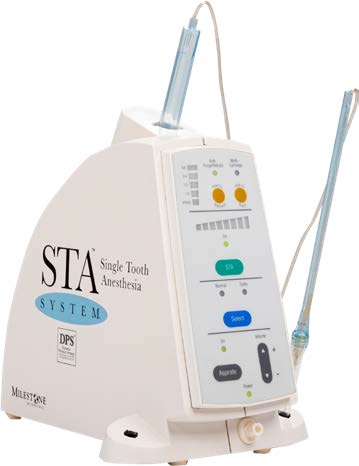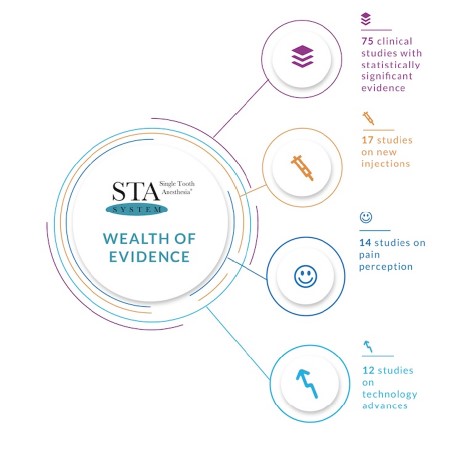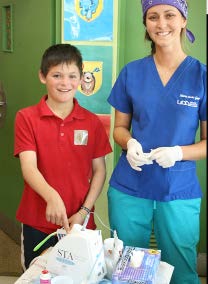
 Step 1: The need to acknowledge that we have problem
Step 1: The need to acknowledge that we have problem
I have been in practice of dentistry for over 35 years, and I never met a dentist who hasn’t told me he/she gives a “painless injection”. However, this contradicts one of the most widely reported findings in dentistry; that our patients have a very high-level of fear and anxiety related to receiving a dental injection. So, how can that be if we in the profession are giving these “painless injections”? The truth of the matter is, we are not. And I am here to tell you, it’s not your fault. It’s the fault of the device you are using, the traditional dental syringe. The fact is, if you are still using a standard dental syringe, you are using a piece of equipment that dates back to the late 1800’s. It is an antiquated technology that cannot control the most important variables when giving an injection. The good news however, is there are some innovative new devices available in dentistry that will vastly improve the way you give an injection and even allow you to finally give a “painless injection”.
The dental syringe you are using today dates to the 1850’s. I ask you what other instruments in your armamentarium dates to the turn-of-the-century? We have entered the age of digital dentistry. Everything from radiographs to impressions are performed with micro-processor driven technologies and for good reason. It introduces precision, ease-of-use, and a better way to control variables for a given task. That is exactly what a computer-controlled Local Anesthetic delivery (C-CLAD) device can do for you when performing a dental injection for your patients.

Digital Dentistry’s answer to an age-old problem
The Wand/STA System instrument represents the world’s first and only technology that uses the patented Dynamic Pressure Sensing Technology® (DPS) that accurately and safely performs a pressure regulated Intra-Ligamentary Periodontal dental injection.1 The Wand/STA System can also perform all your traditional dental injection techniques i.e., Inferior Alveolar Block, Supra-periosteal infiltration, etc. However, these techniques are performed more efficiently, more effectively and virtually painlessly using the Wand/STA System.2,3 The system incorporates visual and audible real-time feedback giving clinicians an unprecedented level of control and information when performing a dental injection. It replaces a heavy, metal dental syringe with an ultra-light-weight disposable hand-piece weighing less then 10 grams for superior ergonomics and tactile control.4 The experience for both patient and dentist has also been shown to be significantly less stressful because patients are more comfortable and cooperative.5
The Wand/STA system is supported by decades of dental research and support the claims of eliminating and markedly reducing pain perception when performing a dental injection.6,7,8,9 This technology has undergone the rigors of being clinically testing in many leading universities and research centers throughout the world for more than two decade.
Clinical research supports adoption of Computer controlled Local Anesthesia Systems today.
A series of clinical studies looking at performing single-tooth anesthesia using the Periodontal Ligament Injection (PDL) have found it to be a highly safe and effective alternative to the Inferior Alveolar Block.10,11,12,13,14,15,16 Garret-Bernardin and co-workers conducted a controlled study with a crossover split mouth design on 67 patients (aged 7 to 15 years).14
Each patient received both types of injections, one with the Wand/STA and one with the traditional syringe. Pain perception was assessed by a visual analog scale and the patient expressed his/her level of satisfaction on a scale from 1 to 10. The Wand/STA System resulted in significantly lower pain ratings versus the conventional syringe with a mean reduction of 1.09 VAS point with the Wand/ STA System compared with traditional syringe (Þ = 0.0003). Patient level of satisfaction demonstrated higher satisfaction with the Wand/ STA System, compared with the traditional anesthesia. In conclusion the authors stated, “the Wand/STA system can provide less painful injections when compared to the conventional local anesthesia in patients and it was better tolerated compared to a traditional syringe”.
The Wand/STA System represents true innovation which your patients will appreciate as another advance in the realm of digital dentistry. A welcomed advance in technology for all your dental patients while providing value added options for newer techniques like the single-tooth injection technique. It provides a new level of safety, comfort, and predictability previously unattainable when compared to the manually driven conventional syringe. C-Clad instruments are the most advanced way to perform a painless injection to-date and that is something all patients will appreciate and agree on.
Author
Mark Hochman is the invertor of the Wand/STA System and currently clinical director or Milestone Scientific Inc. the manufacturer or the Wand/STA System.
Article Published In Dental Solutions May-June 2024
References
1. Hochman MN. Single-Tooth Anesthesia:Pressure sensing technology provides innovative advancement in the field of dental local anesthesia. Compendium 2007;28(4):186-193.
2. Ferrari M, Cagidiaco MC, Vichi A, Goracci C. Efficacy of the Computer-Controlled Injection System STA, the Ligamaject, and the dental syringe for Intraligamentary anesthesia in restorative patients. Intern. Dent SA 2010;11:4-12.
3. Ashkenazi M, Blumer S, Eli I. Effect of computerized delivery intraligamental injection in primary molars on their corresponding permanent tooth buds. Intern. J of Paed Dent 2010;20:270-275.
4. Murphy D. Ergonomics and the Dental Care Worker. ISBN: 0-87553-0233-0. Washington DC, American Public Health Association. 1998.
5. Kudo M. Initial injection pressure for dental local anesthesia: effects on pain and anxiety. Anesth Prog 2005;52:95-101.
6. Ashkenazi M, Blumer S, Eli I. Effective of Computerized Delivery of Intrasulcular Anesthetic in Primary Molars. JADA, 2005;136:1418-1425.
7. Allen KD, Kotil D, Larzelere RE, Hutfless S, Beiraghi S. Comparison of a computerized anesthesia device with a traditional syringe in preschool children. Pediatr Dent. 2002;24:315-320.
8. Ram D, Kassirer J. Assessment of a palatal approachanterior superior alveolar (P-ASA) nerve block with the Wand in paediatric dental patients. Intern J of Paediatr Dent 2006;16:348-351.
9. Jalevik B, Klingberg G. Sensation of pain when using computerized injection technique, the Wand. IADR Pan Federation, Sept 13, 2006. Abstract # 0070.
10. Yogesh-Kumar TD, John JB, Asokan S, Geetha Priya PR, Punithavathy R, Praburajan V. Behavioral response and pain perception to computer controlled local anesthetic delivery system and cartridge syringe. J Indian Soc Pedod Prev Dent. 33(3):223-228, 2015.
11. Yogesh-Kumar TD, Asokan S, John BJ , Pollachi- Ramakrishnan GP, Ramachandran P, Vilvanathan P . Cartridge syringe vs computer controlled local anesthetic delivery system: Pain related behaviour over two sequential visits – a randomized controlled trial. J Clin Exp Dent. 7(4): e513–e518, 2015.
12. Kwak EJ, Pang NS, Cho JH, Jung BY, Kim KD, Park W. Computer-controlled local anesthetic delivery for painless anesthesia: a literature review. J Dent Anesth Pain Med. 16(2):81-88, 2016.
13. Mittal M, Kumar A, Srivastava D, Sharma P, Sharma S. Pain Perception: Computerized versus Traditional Local Anesthesia in Pediatric Patients. Journal of Clinical Pediatric Dentistry. 39(5):470-474, 2015.
14. Garret-Bernardin A, Cantile T, D'Antò V, Galanakis A, Fauxpoint G, Ferrazzano GF, De Rosa S1, Vallogini G, Romeo U, Galeotti A. Pain Experience and Behavior Management in Pediatric Dentistry: A Comparison between Traditional Local Anesthesia and the Wand Computerized Delivery System. Pain Res Manag. Volume 2017, Article ID 7941238, 6 pages https://doi.org/10.1155/2017/7941238, 2017
15. Baghlaf K, Alamoudi N, Elashiry E, Farsi N, El Derwi DA, Abdullah AM. The pain-related behavior and pain perception associated with computerized anesthesia in pulpotomies of mandibular primary molars: A randomized controlled trial. Quintessence Int. 46(9):799-806, 2015.
16. Perugia C, Bartolino M, Docimo R. Comparison of single tooth anaesthesia by computer-controlled local anaesthetic delivery system (C-CLADS) with a supraperiosteal traditional syringe injection in paediatric dentistry. Euro J Paediatric Dentistry 18(3):221-225, 2017